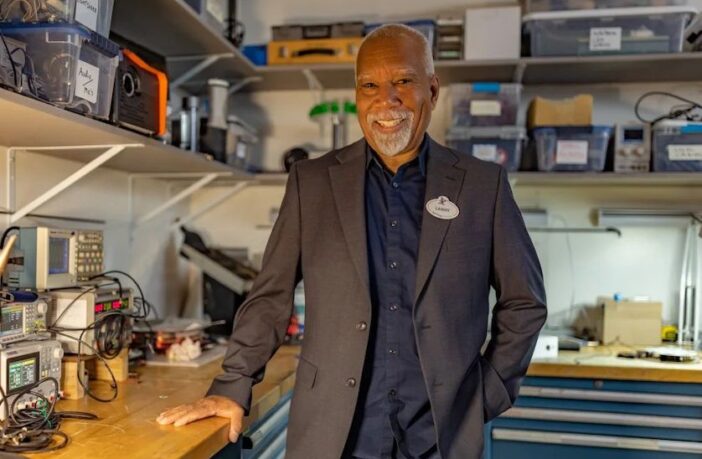Disney Imagineer Lanny Smoot is one of the most prolific Black inventors in the United States.
The Columbia University alum is the brains behind some of Disney’s most iconic tech. He has invented everything from lightsabers to eye imaging for superhero masks and helmets.
For nearly three decades, Smoot has continued to push the boundaries to bring to life awe-inspiring, unrivaled experiences to Disney guests across the globe. The Disney Research Fellow and longtime member of Walt Disney Imagineering R&D is a distinguished inventor and pioneering Black engineer with over 100 patents to his name.
Earlier this year Smoot was inducted into the National Inventors Hall of Fame. The first Disney Imagineer to receive this prestigious recognition.
From his groundbreaking work in interactive technology to his dedication to inspiring the next generation of innovators, Smoot’s contributions are nothing short of extraordinary. In our exclusive interview, Smoot opens up about the challenges and triumphs of being a Black engineer in an industry where representation has historically been lacking.
Growing up with fictional engineers from Star Wars as his role models, Smoot’s journey offers valuable insights into the importance of persistence, innovation, and the power of diversity in shaping the future of technology.
UrbanGeekz: Growing up in Brooklyn, what challenges did you face as a young Black man interested in science and engineering, and how did you overcome them?
Lanny Smoot: I grew up in Brownsville, Brooklyn, which was (and still is) a tough neighborhood, and my parents did not have a lot of money. There were no visible role models for a career in engineering, but my father was a bit of an itinerant inventor, making gadgets that we could use in our apartment. He set me on the track to becoming an inventive engineer when I was about 5 years old when he brought home an electric bell, a battery, some wire, and a lightbulb. He hooked them up, the bell rang and when that bulb lit, it lit up my entire career path ahead of me. From then on, I was interested in everything electrical or electronic. My Mom was not technical, but she gave me the love and support that I still feel now, even though both parents have passed.
Related Post: Disney World Embraces Innovative Digital Technology
The only other available role models were the ones on television in those days: the “Lt. Uhura” character in Star Trek (played by Nichelle Nichols) and the “Barney Collier” character (played by Greg Morris) in the original Mission: Impossible television show. Each of these Black characters played technical roles on exciting shows and allowed me to see people who looked like me doing the highly technical things that I wanted to do someday.
As a young kid, I was always trying to build new things, in fact, when I was around 11, I built a unicycle by using the front wheel of a tricycle, a vertical pipe, and a regular bicycle seat. I learned to ride that baffling contrivance, and although they were expensive, I came home from school one day and my Dad had bought me a real unicycle! I think that loving coaching was why I so enjoy doing technically creative work today.
The rest is history, and I attended Brooklyn Tech (an amazing test school in the State of New York), and ultimately went to Columbia University for both my BSEE and MSEE degrees paid for by scholarships from Bell Labs.
Interestingly enough, I presented Brooklyn Tech’s graduating class’s Keynote address last year, and Columbia University’s engineering graduating class keynote this summer!
UrbanGeekz: Can you share the story behind your first patent? How did that moment shape your career, particularly as a Black inventor in a predominantly white industry?
Lanny Smoot: As we all know, necessity IS the mother of invention. When I joined Bell Labs as a young engineer, the telephone network was based solely on copper wire pairs that connected phones (I helped fiber optics change that years later). Telephone companies ran bundles of wire in underground conduits as new neighborhoods sprang up. Sometimes they underestimated the growth of a neighborhood and would need more wire to connect phones, especially coin telephones (that’s right, we used to put coins into public phones!). That would mean digging up streets to add additional conduits (an extremely expensive and time-consuming endeavor). My first patent helped allow 4 separate coin telephones to work independently on each wire pair, and without interfering with each other. In most cases, this was enough of a multiplier to support even the fastest growing communities. That first patent was appreciated by my peers and, of course, my company as it saved them money, and certainly gave inspiration to other young Black engineers. After receiving a first patent and passing that initial hurdle, it became more comfortable to go through the required rigor and process to garner a second… and third… protection of my inventions.
Related Post: Meet the Highflying Senior Exec Making Waves at Walt Disney World
UrbanGeekz: As Disney’s most prolific inventor, how do you approach the challenge of balancing creativity with technological innovation in your projects?
Lanny Smoot Ha!Ha! Creativity and technical innovation go hand in hand. There are many engineers who do a great job but may not be particularly inventive. I like to create systems that work in new and different ways. This meshes well with the goal of Disney Imagineers which inherently embodies creativity. In cases where my “purely artistic” creativity may not be up to the task, I can always find partners at The Walt Disney Company who are artistic auteurs and we can share our respective talents to come up with something that is not only novel technically, but is also attractive and even more fun to see or use.
UrbanGeekz: How important is it for you to be a visible figure in STEM for young Black engineers, and what advice would you give to those aspiring to follow in your footsteps?
Lanny Smoot: It is extremely important to me to pass on any knowledge or inspiration that I can, to the young people that want to move into technical, or even other, fields. I don’t want this new group of learners, especially those that look like me, to have to find fictional role models as I did.
Today Black engineers and inventors are more accessible, both living, AND those who have passed (and are being more celebrated nowadays). I was both humbled, and elated, at having been inducted into the National Inventors Hall of Fame earlier this year. This is where many engineers, scientists and of course inventors from across the country are honored, and if you Google the many honorees celebrated there, you will see a growing number of people of color who are receiving this honor. Each of these recipients do their best to make sure that all young folks can pursue careers of constant creativity.
UrbanGeekz: Many of your patents are tied to creating immersive experiences that blend storytelling with technology. How do you see the role of cultural identity in the work you do at Disney?
Lanny Smoot Interesting that you ask this, as the “Water Harps” of my design and invention were recently installed in the “Journey of Water Inspired by Moana” attraction at EPCOT at Walt Disney World. These harps have “strings” of smoothly falling water and can be played as an instrument by strumming the streams. Moana is a relatively new cultural character in the world of Disney as the company continues to expand its celebration of multiple cultures. I’m happy that my technologies can be used to help expand upon this cultural storytelling.
Related Post: Teens Inspired to Take On the World with Disney Dreamers Academy
UrbanGeekz: Looking ahead what excites you most about the future of engineering and entertainment, and what projects or technologies are you most eager to develop next?
Lanny Smoot: That’s a hard one, as I am always most interested in my most recent projects until the next exciting opportunity comes along, and right now, I’m really interested in the potential of my HoloTile™ Floor. It is the world’s first omni-directional treadmill floor, that can support any number of persons walking on its surface in any direction that they choose. Every single part of the Floor can move anything on it in any direction. People walking on it in any direction will never collide with each other, or walk off the Floor, as it has sensors that detect the direction and speed that a person is walking and counters their movement.
When people on the HoloTile™ Floor are wearing head-mounted displays synched to the Floor, they can explore, and walk throughout, any fictional or real environment. Harkening back to my early years of watching Star Trek, I grew to want to have a Holodeck, and now I’ve made one!
Lanny Smoot’s work today continues to innovate at the intersection of storytelling and technology. Serving as a beacon for future generations of Black Engineers, inventors, and other scientists. His journey from humble beginnings in Brooklyn to becoming one of the most prolific inventors at Disney shows the power of perseverance, creativity, and representation. Smoot’s story is more than just a career path, it’s a legacy that opens doors for others to dream bigger, push boundaries, and make their mark on the world.
Photo Credit: Lanny Smoot Courtesy of Disney Enterprises, Inc.



